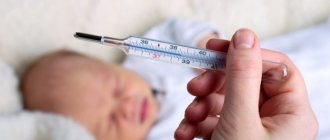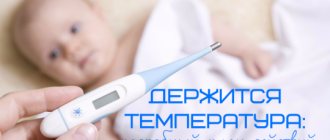An elevated body temperature in a child, as in an adult, indicates the presence of some kind of infection in his body. The first question that many mothers ask is: “How long can a child’s fever last if he has a certain disease?” To find the answer to this question, you first need to find out the reason why the temperature increased. To clarify this circumstance, first of all, you need to call a local doctor or an ambulance. Often parents take such measures when the temperature rises to 38 degrees or more, but a serious infection can occur in the body even at the most nasty, but not so high temperature of 37°C. Therefore, consulting a doctor is necessary in any case if the child’s health is in question and his condition is of concern.
Normal temperature limit in children
The healthy body of a child, like an adult, performs and stabilizes many vital functions, while the body produces a certain amount of heat. The processes that are responsible for maintaining this heat and its balance are completely related to the state of health of the child. An imbalance in heat indicates the presence of a viral infection in the body, therefore.
The normal body temperature in children in the armpit is considered to be 36 - 37 degrees, and in the rectum at rest the baby is 0.5 - 1 degree more. Of course, if the temperature lasts more than 6 days, then the processes responsible for its balance have obviously gone wrong and are not working correctly. In this case, immediate contact with a doctor is required.
The reaction to the presence of a certain infection in children of different ages may be different, in which case the level of increase in body temperature in each child will also be different. Every day the baby grows up, and, taking this into account, the balance of heat and stability of body temperature may gradually change.
If an infant's body temperature changes several times a day and gives the impression of a fever, then most likely the body is infected with a viral infection.
With such jumps in heat exchange disturbances, the presence of a disease is more difficult to detect than in the case of a consistently elevated temperature.
We measure the temperature
Modern parents have a lot of devices at their disposal with which they can do this.
For example, body temperature in children under one year old can be measured using a pacifier equipped with a special monitor, or a plate that can simply be glued to the forehead. Such devices are safe, but many parents still consider proven electronic thermometers to be the most reliable, and mercury devices do not lose their relevance.
Currently on sale you can find thermometers with flexible tips that can be used for children under one year and older for safety reasons.
You can find out whether your baby has a temperature or not in different ways. This depends not only on the type of thermometer we use, but also on the part of the body where we measure the temperature.
- In the armpit. When measuring the temperature in this area, the thermometer must be placed in such a way that its entire head is in it. Normally, the temperature here in infants is 36.4-37.3 degrees. But the thermometer scale can rise even higher if, for example, the baby is outside in hot weather, he begins to have colic, which often happens in toddlers who are not yet one year old, or he cries. In such cases, the temperature may be 37.6-38 degrees, but the baby is healthy. When a child eats, the normal body temperature is 37-37.2 degrees, if measured in the armpit. The thermometer in this area may also show a lower value - 35.8-36.5 degrees, which accompanies hypothermia of the baby. A sign of this is the toddler’s capriciousness and crying.
- Rectally. The results may vary. The norm in this case will be figures such as 36.9-37.6 degrees. The optimal time for taking measurements is when the baby is sleeping, since he should be at rest during this procedure. If the baby is active or has just eaten, the temperature may rise to 38 degrees, which is not a disease or a cause for concern.
- Oral. The thermometer is placed in the baby's sublingual space, and his mouth should be closed. In children under one year old, temperature measurement is rarely done in this way, since it is not very convenient, and the results may be unreliable. But if we talk about the norms of temperature indicators when measured orally, then they are 36-37.1 degrees.
In addition to the fact that babies under one year old have some physiological characteristics, you need to remember that approximately 1/10 of the inhabitants of our planet have a temperature reading that differs from the norm, which is prescribed in medical reference books, and can fluctuate in the range of 36-38 degrees. It is possible to say that this is the norm for a particular child or adult only if the presence of such a temperature does not bother him and it is not accompanied by other symptoms that may indicate pathology.
Types of degrees of possible increases in body temperature
Medical theory divides the increase in body temperature in children into several degrees: - subfebrile - from 37 to 38 degrees; - febrile (increased) - from 38 to 39 degrees; — pyretic (high) — from 39 to 41 degrees; - hyperpyrectic - higher than or equal to 41 degrees. If the child’s body temperature rises sharply and already reaches 39 degrees, it is necessary to urgently call an ambulance. This process of rapid increase is caused by acute viral respiratory infections and is almost impossible to do without the help of a specialist. If, after starting treatment, the temperature does not subside and lasts for about a week, then there is a possibility that the treatment was incorrectly prescribed, and, most likely, the disease has acquired a degree of relapse.
How many days does the temperature last
With a standard clinical picture, the temperature appears between the 10th and 12th day of illness. Covid-19 sometimes behaves unpredictably. Symptoms may appear after 2-3 days. In severe forms, hyperthermia usually appears within 1 week of illness. How long does the temperature last for coronavirus in children, what happens, as evidenced by:
- The child has a fever for 5 days. The body successfully copes with the viral infection.
- If it lasts more than 7 days, medical help is needed. Immunomodulators are prescribed to prevent the development of pathological changes.
- Elevated, but fluctuates within 2 weeks. The body cannot cope with coronavirus, there is a high probability of pneumonia, and hospitalization is necessary.
On a note!
After the child is ill, the temperature may drop below standard values. Do not be alarmed, this is evidence that the body is slightly weakened; it will soon recover quickly.
How many days is a high temperature considered normal?
How many days can a child have an elevated temperature if there is an infection in his body? For what types of diseases is a prolonged increase in temperature in children considered completely normal? When a child’s body temperature rises to 38 degrees, his body’s defenses begin to produce interferon, which affects the body’s perception of a viral infection. Bacteria, viruses and infections begin to die in the body at high temperatures. As a result, with such serious diseases as purulent tonsillitis, pneumonia and otitis media, a child’s fever can last for 6 or more days, and this is considered quite normal. It is worth paying attention to the fact that a child may not always physically let you know about the appearance of a virus in his body and an increase in temperature. If a typical fever is present, the child may behave as usual, running and playing. This suggests that the body is still in the initial stages of infection. This feature of symptoms is also characteristic of viral diseases such as influenza and parainfluenza.
The first sign of viral and bacterial infection is a temperature of 38 degrees for six or more days (as with sore throat). If a child has a fever, he or she should immediately be placed on bed rest, drink plenty of fluids, and call a doctor at home.
Differences in the duration of viral fever depending on age
Viral fever in young children can last up to 4-6 days, about twice as long as in older children. Here we consider 3 years to be the transitional age.
Infants, in turn, are not as adaptable to the virus as older children when it comes to temperature regulation, and therefore the temperature in children under 4-6 months of age can be unpredictable, and a high temperature of 39-40 degrees at this age is always necessary keep under control.
In general, a child's immune system is not as strong as an adult's, which means they are more susceptible to viruses. The duration of a viral temperature with values up to 40 degrees in children can be 2-3 days longer than in adults.
It is also important to keep in mind that a high temperature does not directly indicate the severity of the infection. In some cases, a minor virus can cause a high viral temperature even above 40℃, while a more serious infection can cause a milder fever.
While it is dangerous to leave high viral temperatures in children unattended, you also should not ignore low temperatures - even 37℃ if it lasts long enough - longer than 4-5 days.
In what case is it necessary to “bring down” the elevated temperature?
If the baby’s temperature level remains up to 38 degrees, then you need to try not to knock it down, this will make it easier for the pediatrician to identify the cause of the malfunction. It is necessary to take into account that the drugs Cefekon-M, Analgin and Antipirin are prohibited for use by children (for 20 years). The main antipyretic that is usually prescribed to a baby is Paracetamol (even if the illness lasts six days or more). Nurofen and Ibuklin are good medicines for children. Special attention should be paid to the increase in temperature in children with nervous disorders or cardiovascular diseases. In the presence of such pathologies, it is necessary to reduce the temperature immediately when it reaches 38 degrees, otherwise convulsions may occur.
How many days is high temperature possible?
How many days the high temperature will last depends on the duration of the disease and is determined by the following facts: 1. Symptoms of the disease and its form. For example, catarrhal sore throat lasts less than purulent sore throat, in which the temperature level may rise to 38 degrees or more. 2. Baby's age. The older the baby is, the faster the body temperature returns to normal and recovery begins. 3. Immune system. If the immune system is strong, then the disease will not last long and the baby’s general condition may return to normal within 3-4 days. How correctly the treatment is prescribed also determines its effectiveness and how many days the disease will last. At temperatures above 38 for a long time, only a pediatrician should prescribe treatment for children. First, he prescribes the necessary laboratory tests or studies, and only then, based on the results obtained, he prescribes the necessary medications or folk remedies. When prescribing any drug or recommendation, the pediatrician takes into account the individual characteristics of each baby.
The main rule for any parent is not to panic if the baby’s body temperature remains at 37-38°C for more than seven days.
If the doctor is informed about each stage of the development of the disease and has already prescribed everything necessary for the recovery process, but the temperature still remains high, in most cases this is normal. Most likely, the body fights the onset of the disease in this way, and quite successfully.
How to act correctly
ARVI in adults is unpleasant, but for a child to survive the infectious process can be even more difficult. Therefore, it is very important to properly organize treatment and support for the body. The surest and most important step is to contact a doctor, since it is not always possible to cure a baby on your own, and often due to irrational actions a lot of complications arise, or the illness lasts a very long time, which literally deprives the baby of vitality.
You should remember these rules:
- At the initial manifestations of the disease (nasal discharge, tingling in the throat, temperature 37 and above), a doctor is called to examine the baby and make a diagnosis and prescribe treatment. Calling a doctor is especially necessary if we are talking about illness in an infant or child under 1 year old, or the temperature has been elevated for more than 3 days, or the temperature has risen to 40° or higher. The pediatrician needs to ask how many days the fever can last, when and what medications should be given.
- If the child does not have concomitant diseases (epilepsy, heart disease, predisposition to seizures), a temperature of up to 38 degrees during ARVI in children is not considered dangerous, which means it is not advisable to bring it down. On the contrary, at this time there is an active process of fighting viral particles in the body; it should not be interfered with. You can only help your baby survive this period by providing him with plenty of fluids, since over time, even with such thermometer readings, dehydration develops. If your baby has the health problems listed above, you can’t take risks; you need to ask your doctor when to give an antipyretic in this case.
- Regardless of how long the temperature lasts for a cold, the baby should be provided with bed rest for this entire time. Experiencing fever in the legs weakens the child and increases the duration of rehabilitation.
- A temperature of 37 degrees or more provokes chills. But you should not wrap or dress the baby warmly, this will make him worse, because this will interfere with heat transfer.
- It is necessary to treat all manifestations of the disease simultaneously. A sick child is given antiviral medications, solutions are prepared for rinsing the throat, and drops are instilled into the nose. One of the most common misconceptions that has existed for many years is the need for antibiotics for colds. Viral infections cannot be treated with antibacterial agents! If a bacterial infection is also detected, the doctor will prescribe antibiotics.
- How many days a fever can last for ARVI depends on the activity of the immune system. If she manages to destroy pathogens in a short time, the baby recovers faster. It is advisable to support his body: more often give fruits, fermented milk drinks and other healthy and vitamin-rich foods.
- It is recommended to ventilate the room at least once a day. In this way, exhaled viral particles are eliminated from the air, and the atmosphere in the room becomes more humid, so the baby will be less bothered by a dry throat and coughing attacks.
Tips for proper treatment of the onset of illness
No matter how many days the illness lasts and no matter what kind of treatment is carried out, it is necessary to adhere to a certain regimen and treatment schedule. - Regardless of how long the elevated body temperature lasts, it is necessary to immediately provide bed rest to the child. In case of long-term illness, you can keep your baby busy with quiet games or reading books. The fewer sudden and prolonged movements he makes, the less risk of complications. — It is necessary to remember that the dosage and duration of use of drugs directly depends on the age of the child. — Often, the pediatrician prescribes antibiotic treatment. If the baby’s body temperature does not decrease within seven days, then they must be continued in the amount prescribed by the pediatrician.
If the high temperature lasts for more than seven days, and there is not the slightest sign of a decrease?
If you have a temperature of 38 or above for more than seven days, you should call emergency medical care. An ambulance is urgently needed if the increase occurs after taking antipyretic drugs. The arriving doctors will assess the condition of the sick baby. If the lungs are in order and he breathes cleanly, then doctors will use a lytic mixture (the so-called triad) to sharply lower body temperature. In extreme cases, hospitalization is suggested. At the hospital, the necessary examination will be carried out and, if necessary, the child will be given an IV to stabilize the condition. It must be remembered that the key to a successful and speedy recovery of the baby lies in a timely visit to the pediatrician and during the prescribed treatment.











